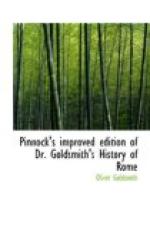4. The next addition made to the city was the Sabine town,[2] which occupied the Quirinal and part of the Capitoline hills. The name of this town most probably was Qui’rium, and from it the Roman people received the name Quirites. The two cities were united on terms of equality, and the double-faced Ja’nus stamped on the earliest Roman coins was probably a symbol of the double state. They were at first so disunited, that even the rights of intermarriage did not exist between them, and it was probably from Qui’rium that the Roman youths obtained the wives[3] by force, which were refused to their entreaties. 5. The next addition was the Coelian hill,[4] on which a Tuscan colony settled; from these three colonies the three tribes of Ram’nes, Ti’ties, and Lu’ceres were formed. 6. The Ram’nes, or Ram’nenses, derived their name from Rom’ulus; the Tities, or Titien’ses, from Titus Tatius, the king of the Sabines; and the Lu’ceres, from Lu’cumo, the Tuscan title of a general or leader.[5] From this it appears that the three tribes[6] were really three distinct nations, differing in their origin, and dwelling apart.
7. The city was enlarged by Tullus Hostilius,[7] after the destruction of Alba, and the Viminal hill included within the walls; Ancus Martius added mount Aventine, and the Esquiline and Capitoline[8] being enclosed in the next reign, completed the number of the seven hills on which the ancient city stood.
8. The hill called Jani’culum, on the north bank of the Tiber, was fortified as an outwork by Ancus Martius, and joined to the city by the bridge; he also dug a trench round the newly erected buildings, for their greater security, and called it the ditch of the Quirites. 9. The public works erected by the kings were of stupendous magnitude, but the private buildings were wretched, the streets narrow, and the houses mean. It was not until after the burning of the city by the Gauls that the city was laid out on a better plan; after the Punic wars wealth flowed in abundantly, and private persons began to erect magnificent mansions. From the period of the conquest of Asia until the reign of Augustus, the city daily augmented its splendour, but so much was added by that emperor, that he boasted that “he found Rome a city of brick, and left it a city of marble.”
10. The circumference of the city has been variously estimated, some writers including in their computation a part of the suburbs; according to Pliny it was near twenty miles round the walls. In consequence of this great extent the city had more than thirty gates, of which the most remarkable were the Carmental, the Esquiline, the Triumphal, the Naval, and those called Tergem’ina and Cape’na.
11. The division of the city into four tribes continued until the reign of Augustus; a new arrangement was made by the emperor, who divided Rome into fourteen wards, or regions.[9] The magnificent public and private buildings in a city so extensive and wealthy were very numerous, and a bare catalogue of them would fill a volume;[10] our attention must be confined to those which possessed some historical importance.




